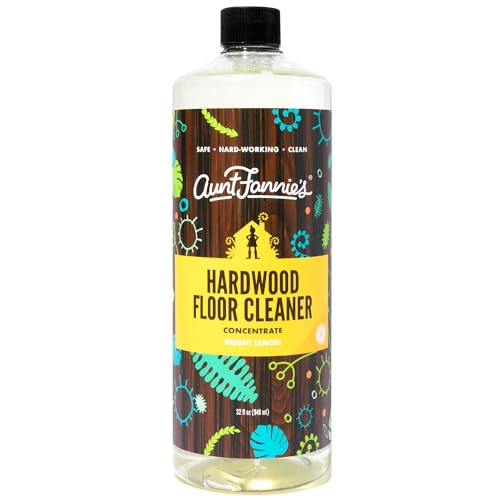

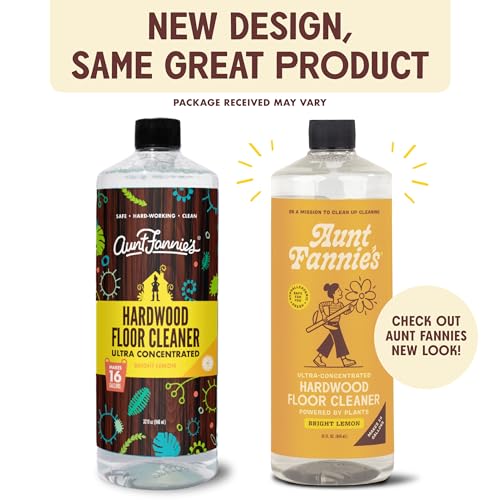
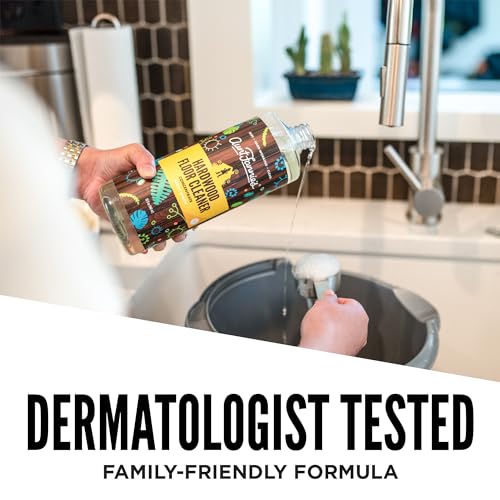
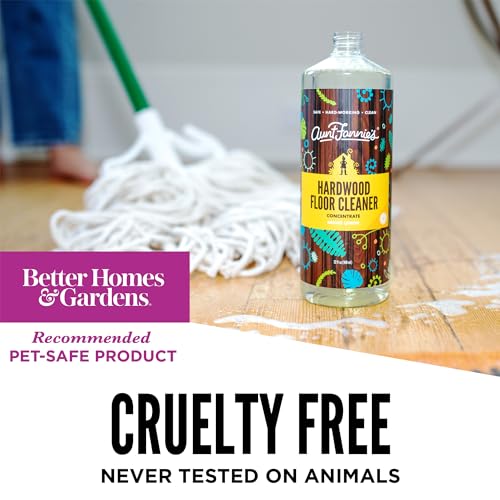

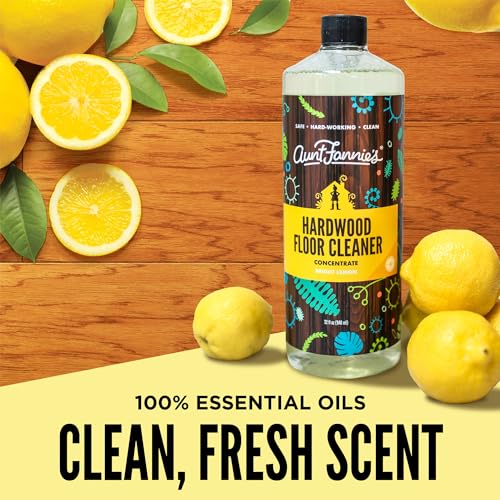

Aunt Fannie's Floor Cleaner - Plant-Based, Safe for Kids & Pets, Bright Lemon Scent - 32 oz.


Picea Mariana Leaf Oil
High RiskPicea mariana leaf oil, derived from the needles of the black spruce tree, is commonly used in personal care products for its aromatic properties and potential skin benefits. It functions primarily as a fragrance component and may also have preservative qualities due to its natural antimicrobial properties.
Sustai Insights
Picea mariana leaf oil offers functional benefits as a natural fragrance and potential antimicrobial agent, which can enhance product stability. However, it carries high usage restrictions and is associated with low risk for carcinogenicity, allergies, and reproductive toxicity. Environmental concerns include potential pollution and bioaccumulation. Regulatory warnings indicate heightened caution in use. Overall, the ingredient presents a high risk assessment, and users are advised to consider safer alternatives or limit exposure.
Citric Acid
Medium RiskCitric acid is an alpha hydroxy acid used in personal care products primarily for its role as a pH adjuster and natural preservative. It occurs naturally in citrus fruits and is commonly utilized in various formulations for its chelating properties and mild exfoliation benefits.
Sustai Insights
Citric acid offers functional benefits as an effective preservative and pH stabilizer, contributing to product longevity and stability. It is biodegradable and derived from renewable sources. Health risks are low, with minimal concerns regarding carcinogenicity, allergies, and reproductive toxicity. However, moderate use restrictions exist due to potential irritation at high concentrations. Environmental risks are limited, as citric acid is not known to accumulate in ecosystems. Regulatory agencies have no significant advisories against its use. Overall, it is assessed as a medium-risk ingredient, with safe usage practices recommended and alternatives available.
Citrus Aurantium Dulcis (Orange) Peel Oil
Medium RiskCitrus aurantium dulcis (orange) peel oil is derived from the peel of oranges and is commonly used in cosmetic and personal care products for its fragrance and potential skin benefits. It is known for its aromatic properties and is often included in formulations aimed at enhancing scent profiles.
Sustai Insights
Citrus aurantium dulcis (orange) peel oil offers functional benefits such as providing a pleasant scent and potential antimicrobial properties. However, it poses a high allergy risk and may cause skin irritation in sensitive individuals. Environmental concerns include moderate persistence and potential to contribute to pollution. Regulatory warnings indicate restrictions on use in certain products. Overall, the risk level is assessed as medium, and users are advised to practice caution, particularly those with known allergies. Alternatives like sweet orange essential oil may provide similar benefits with potentially lower risks.
Potassium Sorbate
Medium RiskPotassium sorbate is a potassium salt of sorbic acid, primarily used as a preservative in food and cosmetic products. It inhibits the growth of molds, yeast, and some bacteria, extending the shelf life of products. It is commonly found in various formulations due to its effectiveness and low toxicity.
Sustai Insights
Potassium sorbate serves as an effective preservative, preventing microbial growth in food and cosmetic products, which is vital for safety and longevity. Although it has a low risk of carcinogenicity and developmental toxicity, there is a moderate concern regarding allergies and immunotoxicity. Environmentally, it poses minimal risks as it is not significantly bioaccumulative. Regulatory agencies have verified its use, although some products may face restrictions. Overall, it is assessed as a medium risk ingredient, with safe usage practices recommended, and alternatives such as natural preservatives could be considered.
Sodium Benzoate
Medium RiskSodium benzoate is a preservative commonly used in food and cosmetic products to prevent microbial growth and extend shelf life. It is derived from benzoic acid and is effective at low concentrations, often used in acidic environments like beverages and condiments.
Sustai Insights
Sodium benzoate serves effectively as a preservative, contributing to product stability and safety. It is generally recognized as safe with low concerns for carcinogenicity, allergies, and reproductive toxicity, though it faces moderate use restrictions in some regions. Environmental risks include its potential as a pollutant, but it does not bioaccumulate significantly. Regulatory bodies have issued advisories regarding its concentration in products. Overall, the risk level is assessed as medium, with safe usage practices recommended. Alternatives such as potassium sorbate may provide similar benefits with potentially lower restrictions.
Mentha Piperita (Peppermint) Oil Extract
Low RiskMentha piperita (peppermint) oil extract is derived from the peppermint plant and is commonly used in various products for its aromatic and flavoring properties. It serves multiple functions, including acting as a fragrance agent and providing a cooling sensation in topical applications.
Sustai Insights
Mentha piperita oil offers functional benefits such as flavor enhancement and a refreshing aroma, while it is generally recognized as low risk for health concerns, including carcinogenicity and allergies. Environmentally, it does not contribute significantly to pollution or bioaccumulation. Regulatory bodies do not impose restrictions on its use. Safe usage practices include avoiding excessive exposure, particularly for sensitive individuals. Alternatives like spearmint oil may be considered, but overall, this ingredient is assessed as low risk.
Water
Low RiskWater is a clear, colorless liquid essential for various biological processes. It serves as a solvent in formulations, facilitating the dissolution of other ingredients and enhancing product texture and application. Additionally, water plays a crucial role in hydration and is a key component in many cosmetic and personal care products.
Sustai Insights
Water is an effective solvent and hydrator, contributing to the texture and efficacy of formulations. It is biodegradable and generally regarded as safe, with low concerns regarding carcinogenicity, allergies, and reproductive toxicity. However, excessive water usage can lead to environmental concerns, particularly regarding resource depletion. Regulatory bodies do not impose restrictions on water use in cosmetics. Overall, the risks associated with water are low, making it a safe and essential ingredient.
Myristyl Glucoside
Low RiskMyristyl glucoside is a surfactant derived from myristic acid and glucose. It functions primarily as an emulsifier and cleansing agent in cosmetic and personal care products, helping to stabilize formulations and enhance the texture of products.
Sustai Insights
Myristyl glucoside offers functional benefits as an effective emulsifier and surfactant, contributing to product stability and usability. It is biodegradable and can be sustainably sourced. Health risks are generally low, with minimal concerns regarding irritancy, allergies, or reproductive toxicity. Environmental risks are also low, with no significant pollutant or bioaccumulation potential. Regulatory bodies do not impose significant restrictions on its use, indicating a low overall risk level. Safe usage practices should be followed, and potential alternatives include other plant-derived surfactants. Overall, the ingredient is assessed as low risk.
Caprylyl Glucoside
Low RiskCaprylyl glucoside is a surfactant derived from coconut oil and glucose, commonly used in cosmetic formulations. It functions as a cleansing agent that helps to solubilize oils and dirt, allowing for effective cleansing in personal care products. This ingredient is often included in formulations that require mildness and compatibility with skin.
Sustai Insights
Caprylyl glucoside exhibits functional benefits as a mild surfactant and cleanser, making it suitable for sensitive skin formulations. It is biodegradable and derived from renewable resources, enhancing its sustainability profile. Health risks are generally low, with minimal concerns for irritation and allergies. Regulatory assessments indicate it is safe for use with no significant restrictions. Given its low health and environmental risk profile, it is considered a low-risk ingredient overall. Users are advised to adhere to product instructions to minimize any potential irritation.
Triethylhexyl Citrate
Low RiskTriethylhexyl citrate is a triester of 2-ethylhexanoic acid and glycerin. It functions primarily as a skin-conditioning agent and emollient in cosmetic formulations, enhancing the texture and feel of products while providing moisture retention.
Sustai Insights
Triethylhexyl citrate offers functional benefits as a skin-conditioning agent, promoting moisture retention and product stability. It is considered to have low health risks, including negligible concerns regarding carcinogenicity, allergies, and reproductive toxicity. Environmentally, it poses minimal pollution risk and is not bioaccumulative. Regulatory assessments indicate no significant concerns, affirming its low-risk status overall. Safe usage practices are recommended, and while safer alternatives exist, this ingredient remains a suitable choice in formulations.
Sodium Citrate
Low RiskSodium citrate is used in cosmetic formulations primarily as a buffering agent, helping to stabilize pH levels. It is derived from citric acid and is commonly found in various personal care products to enhance their efficacy and stability.
Sustai Insights
Sodium citrate offers functional benefits such as effective pH regulation and acts as a mild preservative. It is generally recognized as safe with low risks for cancer, allergies, and reproductive toxicity. Environmental concerns are minimal, with no significant pollutant potential or bioaccumulation. Regulatory bodies like the FDA and COSMOS have no major restrictions on its use. Overall, sodium citrate presents a low risk, making it a viable ingredient in cosmetic formulations. Safe usage practices should be followed, and alternatives are not typically necessary.
Citrus Limon (Lemon) Peel
Low RiskCitrus limon (lemon) peel is derived from the outer skin of lemons and is commonly used in cosmetic formulations for its aromatic properties and potential skin benefits. It serves primarily as a fragrance agent and may also provide antioxidant effects.
Sustai Insights
Citrus limon (lemon) peel is valued for its aromatic contributions and potential antioxidant properties, which can enhance product appeal. It has a low risk of adverse health effects, including low concerns for carcinogenicity, allergies, and irritation. Environmental risks are minimal, with no significant evidence of bioaccumulation or pollution. Regulatory assessments indicate no restrictions on use. Overall, it is considered low risk, and safe usage practices should be maintained. Alternatives may include other citrus peels or natural fragrance compounds.
Mentha Piperita (Peppermint) Oil Extract
Low RiskMentha piperita (peppermint) oil extract is derived from the peppermint plant and is commonly used in various products for its aromatic and flavoring properties. It serves multiple functions, including acting as a fragrance agent and providing a cooling sensation in topical applications.
Sustai Insights
Mentha piperita oil offers functional benefits such as flavor enhancement and a refreshing aroma, while it is generally recognized as low risk for health concerns, including carcinogenicity and allergies. Environmentally, it does not contribute significantly to pollution or bioaccumulation. Regulatory bodies do not impose restrictions on its use. Safe usage practices include avoiding excessive exposure, particularly for sensitive individuals. Alternatives like spearmint oil may be considered, but overall, this ingredient is assessed as low risk.
Water
Low RiskWater is a clear, colorless liquid essential for various biological processes. It serves as a solvent in formulations, facilitating the dissolution of other ingredients and enhancing product texture and application. Additionally, water plays a crucial role in hydration and is a key component in many cosmetic and personal care products.
Sustai Insights
Water is an effective solvent and hydrator, contributing to the texture and efficacy of formulations. It is biodegradable and generally regarded as safe, with low concerns regarding carcinogenicity, allergies, and reproductive toxicity. However, excessive water usage can lead to environmental concerns, particularly regarding resource depletion. Regulatory bodies do not impose restrictions on water use in cosmetics. Overall, the risks associated with water are low, making it a safe and essential ingredient.
Myristyl Glucoside
Low RiskMyristyl glucoside is a surfactant derived from myristic acid and glucose. It functions primarily as an emulsifier and cleansing agent in cosmetic and personal care products, helping to stabilize formulations and enhance the texture of products.
Sustai Insights
Myristyl glucoside offers functional benefits as an effective emulsifier and surfactant, contributing to product stability and usability. It is biodegradable and can be sustainably sourced. Health risks are generally low, with minimal concerns regarding irritancy, allergies, or reproductive toxicity. Environmental risks are also low, with no significant pollutant or bioaccumulation potential. Regulatory bodies do not impose significant restrictions on its use, indicating a low overall risk level. Safe usage practices should be followed, and potential alternatives include other plant-derived surfactants. Overall, the ingredient is assessed as low risk.
Citric Acid
Medium RiskCitric acid is an alpha hydroxy acid used in personal care products primarily for its role as a pH adjuster and natural preservative. It occurs naturally in citrus fruits and is commonly utilized in various formulations for its chelating properties and mild exfoliation benefits.
Sustai Insights
Citric acid offers functional benefits as an effective preservative and pH stabilizer, contributing to product longevity and stability. It is biodegradable and derived from renewable sources. Health risks are low, with minimal concerns regarding carcinogenicity, allergies, and reproductive toxicity. However, moderate use restrictions exist due to potential irritation at high concentrations. Environmental risks are limited, as citric acid is not known to accumulate in ecosystems. Regulatory agencies have no significant advisories against its use. Overall, it is assessed as a medium-risk ingredient, with safe usage practices recommended and alternatives available.
Citrus Aurantium Dulcis (Orange) Peel Oil
Medium RiskCitrus aurantium dulcis (orange) peel oil is derived from the peel of oranges and is commonly used in cosmetic and personal care products for its fragrance and potential skin benefits. It is known for its aromatic properties and is often included in formulations aimed at enhancing scent profiles.
Sustai Insights
Citrus aurantium dulcis (orange) peel oil offers functional benefits such as providing a pleasant scent and potential antimicrobial properties. However, it poses a high allergy risk and may cause skin irritation in sensitive individuals. Environmental concerns include moderate persistence and potential to contribute to pollution. Regulatory warnings indicate restrictions on use in certain products. Overall, the risk level is assessed as medium, and users are advised to practice caution, particularly those with known allergies. Alternatives like sweet orange essential oil may provide similar benefits with potentially lower risks.
Caprylyl Glucoside
Low RiskCaprylyl glucoside is a surfactant derived from coconut oil and glucose, commonly used in cosmetic formulations. It functions as a cleansing agent that helps to solubilize oils and dirt, allowing for effective cleansing in personal care products. This ingredient is often included in formulations that require mildness and compatibility with skin.
Sustai Insights
Caprylyl glucoside exhibits functional benefits as a mild surfactant and cleanser, making it suitable for sensitive skin formulations. It is biodegradable and derived from renewable resources, enhancing its sustainability profile. Health risks are generally low, with minimal concerns for irritation and allergies. Regulatory assessments indicate it is safe for use with no significant restrictions. Given its low health and environmental risk profile, it is considered a low-risk ingredient overall. Users are advised to adhere to product instructions to minimize any potential irritation.
Triethylhexyl Citrate
Low RiskTriethylhexyl citrate is a triester of 2-ethylhexanoic acid and glycerin. It functions primarily as a skin-conditioning agent and emollient in cosmetic formulations, enhancing the texture and feel of products while providing moisture retention.
Sustai Insights
Triethylhexyl citrate offers functional benefits as a skin-conditioning agent, promoting moisture retention and product stability. It is considered to have low health risks, including negligible concerns regarding carcinogenicity, allergies, and reproductive toxicity. Environmentally, it poses minimal pollution risk and is not bioaccumulative. Regulatory assessments indicate no significant concerns, affirming its low-risk status overall. Safe usage practices are recommended, and while safer alternatives exist, this ingredient remains a suitable choice in formulations.
Sodium Citrate
Low RiskSodium citrate is used in cosmetic formulations primarily as a buffering agent, helping to stabilize pH levels. It is derived from citric acid and is commonly found in various personal care products to enhance their efficacy and stability.
Sustai Insights
Sodium citrate offers functional benefits such as effective pH regulation and acts as a mild preservative. It is generally recognized as safe with low risks for cancer, allergies, and reproductive toxicity. Environmental concerns are minimal, with no significant pollutant potential or bioaccumulation. Regulatory bodies like the FDA and COSMOS have no major restrictions on its use. Overall, sodium citrate presents a low risk, making it a viable ingredient in cosmetic formulations. Safe usage practices should be followed, and alternatives are not typically necessary.
Potassium Sorbate
Medium RiskPotassium sorbate is a potassium salt of sorbic acid, primarily used as a preservative in food and cosmetic products. It inhibits the growth of molds, yeast, and some bacteria, extending the shelf life of products. It is commonly found in various formulations due to its effectiveness and low toxicity.
Sustai Insights
Potassium sorbate serves as an effective preservative, preventing microbial growth in food and cosmetic products, which is vital for safety and longevity. Although it has a low risk of carcinogenicity and developmental toxicity, there is a moderate concern regarding allergies and immunotoxicity. Environmentally, it poses minimal risks as it is not significantly bioaccumulative. Regulatory agencies have verified its use, although some products may face restrictions. Overall, it is assessed as a medium risk ingredient, with safe usage practices recommended, and alternatives such as natural preservatives could be considered.
Citrus Limon (Lemon) Peel
Low RiskCitrus limon (lemon) peel is derived from the outer skin of lemons and is commonly used in cosmetic formulations for its aromatic properties and potential skin benefits. It serves primarily as a fragrance agent and may also provide antioxidant effects.
Sustai Insights
Citrus limon (lemon) peel is valued for its aromatic contributions and potential antioxidant properties, which can enhance product appeal. It has a low risk of adverse health effects, including low concerns for carcinogenicity, allergies, and irritation. Environmental risks are minimal, with no significant evidence of bioaccumulation or pollution. Regulatory assessments indicate no restrictions on use. Overall, it is considered low risk, and safe usage practices should be maintained. Alternatives may include other citrus peels or natural fragrance compounds.
Sodium Benzoate
Medium RiskSodium benzoate is a preservative commonly used in food and cosmetic products to prevent microbial growth and extend shelf life. It is derived from benzoic acid and is effective at low concentrations, often used in acidic environments like beverages and condiments.
Sustai Insights
Sodium benzoate serves effectively as a preservative, contributing to product stability and safety. It is generally recognized as safe with low concerns for carcinogenicity, allergies, and reproductive toxicity, though it faces moderate use restrictions in some regions. Environmental risks include its potential as a pollutant, but it does not bioaccumulate significantly. Regulatory bodies have issued advisories regarding its concentration in products. Overall, the risk level is assessed as medium, with safe usage practices recommended. Alternatives such as potassium sorbate may provide similar benefits with potentially lower restrictions.
Picea Mariana Leaf Oil
High RiskPicea mariana leaf oil, derived from the needles of the black spruce tree, is commonly used in personal care products for its aromatic properties and potential skin benefits. It functions primarily as a fragrance component and may also have preservative qualities due to its natural antimicrobial properties.
Sustai Insights
Picea mariana leaf oil offers functional benefits as a natural fragrance and potential antimicrobial agent, which can enhance product stability. However, it carries high usage restrictions and is associated with low risk for carcinogenicity, allergies, and reproductive toxicity. Environmental concerns include potential pollution and bioaccumulation. Regulatory warnings indicate heightened caution in use. Overall, the ingredient presents a high risk assessment, and users are advised to consider safer alternatives or limit exposure.
Experience the power of nature with Aunt Fannie's Ultra Concentrated Hardwood Floor Cleaner. This vinegar-free, plant-based solution offers a refreshing lemon scent while effectively cleaning hardwood floors without harsh chemicals. Perfect for health-conscious consumers and families, it ensures a safe environment for kids and pets.
- Eco-Friendly and Safe: This cleaner is EWG A-rated, making it safe for your family and pets.
- Concentrated Formula: Just 1/2 cup mixed with 2 gallons of water provides a cost-effective solution for sparkling floors.
- Versatile Use: Ideal for all types of hardwood, including engineered and laminated floors, with no rinsing required.
- User-Friendly: Easy to use with mops, cleaning machines, or spray bottles, ensuring a thorough clean without any residue.
- Trusted Brand: Aunt Fannie’s commitment to natural cleaning solutions is backed by positive customer reviews and a full range of household products.
Subscribe & Save with Sustai
- Best Price Guarantee: Always enjoy the lowest prices on sustainable home essentials.
- No Surprises: We’ll notify you before shipping. No hidden fees, ever.
- You’re in Charge: Change, pause, or cancel your subscription anytime with ease.
- Eco-Friendly Deliveries: Our grouped shipments mean less packaging and lower emissions.
Join us on a sustainable journey. Special offers for a limited time! Prices and promotions may change.
Recommended Products
Experience the power of nature with Aunt Fannie's Ultra Concentrated Hardwood Floor Cleaner. This vinegar-free, plant-based solution offers a refreshing lemon scent while effectively cleaning hardwood floors without harsh chemicals. Perfect for health-conscious consumers and families, it ensures a safe environment for kids and pets.
- Eco-Friendly and Safe: This cleaner is EWG A-rated, making it safe for your family and pets.
- Concentrated Formula: Just 1/2 cup mixed with 2 gallons of water provides a cost-effective solution for sparkling floors.
- Versatile Use: Ideal for all types of hardwood, including engineered and laminated floors, with no rinsing required.
- User-Friendly: Easy to use with mops, cleaning machines, or spray bottles, ensuring a thorough clean without any residue.
- Trusted Brand: Aunt Fannie’s commitment to natural cleaning solutions is backed by positive customer reviews and a full range of household products.

You can have at most 2 Sustainable Steals products in your cart
Customer Reviews
Customers’ View
Customers appreciate the effectiveness and eco-friendly nature of this floor cleaner. Many highlight its pleasant lemon scent, which is described as refreshing yet not overpowering. Users frequently commend its cleaning power, noting that it leaves hardwood floors sparkling clean with a slight shine and without any streaks. The product's plant-based ingredients resonate well with environmentally and health-conscious consumers, as it is non-toxic and safe for use around pets and children. Furthermore, customers find it to be a great value for money, praising its concentrated formula that lasts a long time. Overall, users find this product both effective and aligned with their sustainable lifestyle.
AI-generated from the text of customer reviewsThis product is rated 4.6 of 5.0 stars.
It has received 7 reviews.




